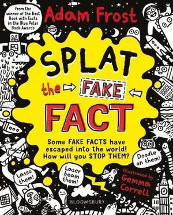Splat the fake fact by Adam Frost

Ill. by Gemma Correll. Bloomsbury, 2018. ISBN 9781408889503
When it comes to free reading choices, young boys, particularly,
tend to go for the non fiction titles about sharks, dinosaurs, motor
vehicles and the "Guinness Book of Records". They are fascinated by
the world of the weird and wonderful that they can pore over and
learn so much from in discussions with their friends as they examine
the pictures even if they can't read the text yet. They are laying
their foundations of the basic concepts of information literacy but
their interest is driven by the illustration rather than a need for
specific information.
Splat the fake fact takes this interest up a notch, encouraging
the reader to actually think about what they are being told,
discover the correct answer through some research and then do
something about it. On every page there are incredible, hilarious,
unlikely facts that are completely true... and one fact that
isn't! The reader is invited to find the imposter fact and reveal it
before it goes out into the world - and then take some action like
scribbling on them, lasering them, drawing silly hats or crossing
them out. While that might not be the recommended action for a
community library book, nevertheless the combination of humour and
cartoon presentation will engage young readers into understanding
that not everything they read is true; that there is real "fake
news" and the need to verify what they see and hear through some
basic research.
While this would make an ideal read for that young person moving on
to independent reading and research, it could also have a place in
information literacy levels with each page being a jump start for an
aspect of the information literacy process. Starting with "What do
we already know?" and "What more do we need to know?" and "Where
could we find that information?" students can be led on that journey
of lifelong learning, developing those core concepts in a way that
connects to the interests of the age group.
While many teachers like to use websites like Save the Pacific
Northwest Tree Octopus to have students to learn to test what they
are reading and evaluate the validity of it, Splat the fake fact
is a few steps before this with its accessible language, funky
illustrations, and graphic layout. Each fake fact is identified,
often in another crazy puzzle that requires more learning to
decipher, but more complete explanations are given at the end of the
book.
Some students might even like to use the puzzles as models to create
their own fake facts, setting up a weekly challenge for library
users to investigate, learning to use the library's resources as
they do.
What looks like a book that might be used as a child's Christmas
stocking stuffer, might just be the best investment you make in your
library collection this year!!!
Barbara Braxton